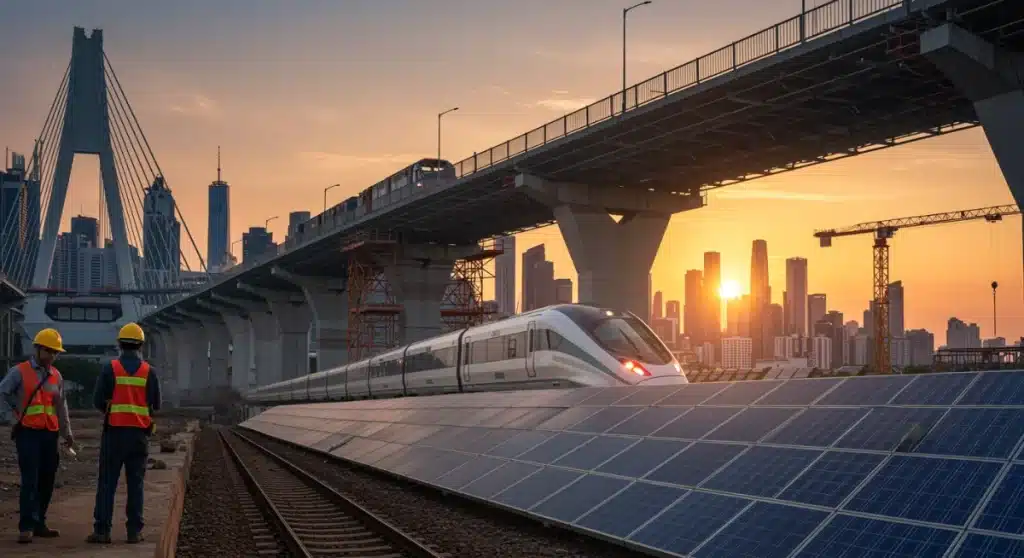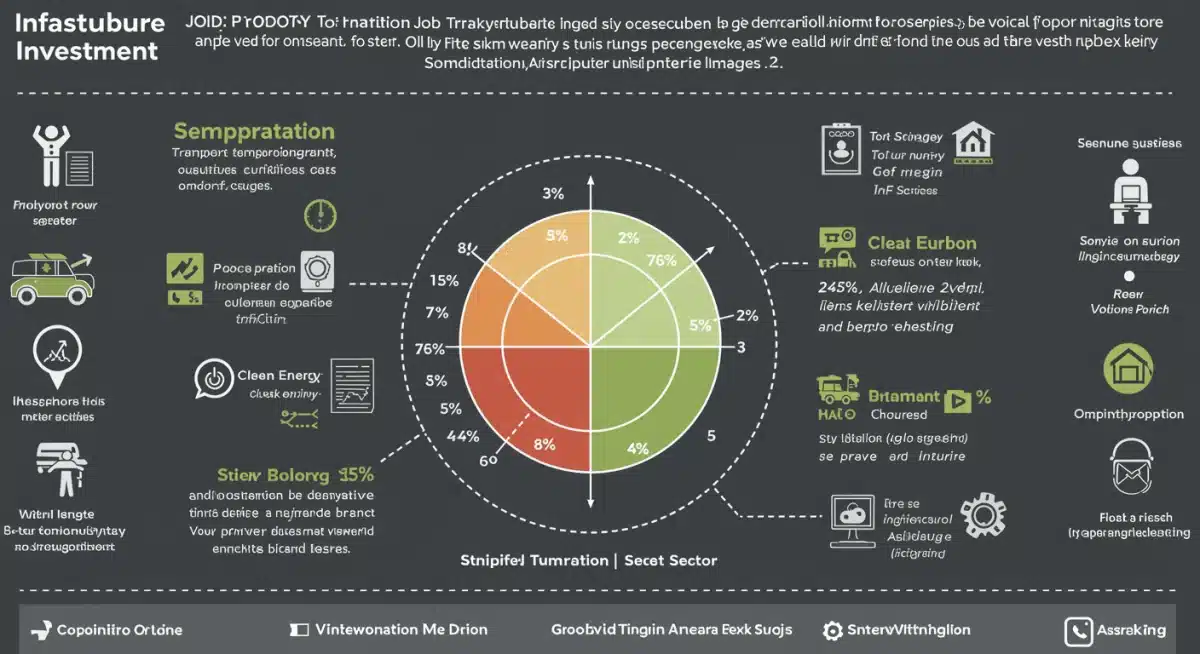2025 Infrastructure Bill: Policy Impacts on Employment & Growth

The 2025 Infrastructure Bill is poised to significantly reshape national employment and economic growth, driving job creation across multiple sectors and stimulating long-term financial prosperity.
The impending 2025 Infrastructure Bill: 7 Key Policy Impacts on National Employment and Economic Growth stands as a pivotal legislative effort, set to redefine the nation’s economic landscape. This comprehensive bill promises to inject substantial funding into critical sectors, sparking both immediate and long-term transformations across the country. What does this mean for you and the economy?
Direct Job Creation in Construction and Manufacturing
The 2025 Infrastructure Bill is expected to be a direct catalyst for massive job creation within the construction and manufacturing industries. As projects ranging from road and bridge repairs to new public transit systems get underway, the demand for skilled labor will surge significantly. This immediate influx of jobs aims to reduce unemployment rates and provide stable opportunities for a diverse workforce.
This policy impact extends beyond mere construction, stimulating related manufacturing sectors. Factories producing steel, concrete, machinery, and various building materials will see increased orders, leading to expansions and further employment opportunities. The ripple effect is anticipated to revitalize industrial hubs and foster regional economic stability.
Skilled Labor Demand Surge
The bill’s focus on complex infrastructure projects will necessitate a highly skilled workforce. This includes engineers, project managers, electricians, welders, and heavy equipment operators. Training programs and apprenticeships are expected to receive increased funding or support to meet this demand.
- Engineers: Design and oversight of new and renovated structures.
- Construction Workers: Direct labor for building and repairing infrastructure.
- Manufacturing Technicians: Production of essential materials and components.
- Logistics Personnel: Management of supply chains for materials and equipment.
Stimulating Economic Growth Through Modernized Infrastructure
Modernized infrastructure is a cornerstone of sustained economic growth, and the 2025 Infrastructure Bill aims to provide just that. By upgrading transportation networks, improving utility systems, and expanding broadband access, the bill reduces operational costs for businesses, enhances productivity, and facilitates smoother commerce. These improvements make regions more attractive for investment and business relocation.
The efficiency gains from better roads and faster internet translate directly into cost savings for companies and consumers. This can lead to increased competitiveness for U.S. businesses on a global scale. Furthermore, improved infrastructure supports the movement of goods and services, preventing bottlenecks and accelerating economic transactions across the nation.
Advancements in Clean Energy and Sustainable Projects
A significant portion of the 2025 Infrastructure Bill is earmarked for clean energy initiatives and sustainable development. This focus will drive innovation and investment in renewable energy sources, energy efficiency projects, and climate-resilient infrastructure. The push towards sustainability creates a new wave of specialized jobs and fosters a green economy.
This policy not only addresses environmental concerns but also positions the U.S. as a leader in green technology. Investments in solar farms, wind energy, electric vehicle charging stations, and smart grids will stimulate research and development, creating high-tech employment opportunities and fostering economic diversification away from traditional fossil fuels. This shift supports long-term ecological and economic health.
Green Job Opportunities
The transition to a greener economy will generate a multitude of new roles, from renewable energy technicians to environmental engineers. These jobs often require specialized training, promoting investment in educational programs focused on sustainable practices and technologies.
- Renewable Energy Technicians: Installation and maintenance of solar panels and wind turbines.
- Environmental Engineers: Designing sustainable infrastructure and waste management systems.
- Electric Vehicle Infrastructure Specialists: Developing and maintaining charging networks.
- Researchers and Developers: Innovating new green technologies and materials.
Enhancing Digital Connectivity and Broadband Access
Broadband access has become as crucial as physical infrastructure in the modern economy. The 2025 Infrastructure Bill includes substantial provisions to expand high-speed internet access to unserved and underserved communities, bridging the digital divide. This enhancement in digital connectivity has profound implications for education, healthcare, and economic participation, particularly in rural areas.
Improved broadband facilitates remote work, online education, and telehealth services, opening up new avenues for employment and skill development. For businesses, reliable internet access is vital for e-commerce, cloud computing, and digital innovation, fostering a more inclusive and competitive national economy. This investment is key to ensuring equitable opportunities for all citizens.

Impact on National Employment Rates and Workforce Development
The cumulative effect of the 2025 Infrastructure Bill’s investments is projected to significantly impact national employment rates. Beyond the direct jobs created, the improved economic environment and increased business activity are expected to generate indirect and induced jobs across various sectors. This comprehensive job growth will contribute to a healthier labor market and higher wages.
Furthermore, the bill will likely spur substantial investment in workforce development programs. As new technologies and construction methods emerge, there will be a continuous need to upskill and reskill the workforce. This proactive approach to labor development ensures that the national workforce remains competitive and adaptable to future economic demands, fostering long-term employability.
Training and Education Initiatives
To support the burgeoning demand for specialized skills, federal and state governments, alongside private industry, are anticipated to launch or expand training initiatives. These programs will focus on equipping workers with the necessary expertise for jobs in construction, clean energy, and digital infrastructure.
- Apprenticeship Programs: Hands-on training for skilled trades.
- Vocational Schools: Specialized education for technical roles.
- Community Colleges: Offering certifications and associate degrees in relevant fields.
- Online Learning Platforms: Flexible options for skill enhancement and retraining.
Supply Chain Resilience and Domestic Production
One critical policy impact of the 2025 Infrastructure Bill is the enhanced focus on strengthening domestic supply chains and boosting national production capabilities. By prioritizing locally sourced materials and labor, the bill aims to reduce reliance on foreign imports and mitigate vulnerabilities exposed by recent global disruptions. This strategic shift supports national security and economic stability.
Investing in domestic manufacturing and infrastructure not only creates jobs but also ensures that the U.S. has the capacity to produce essential goods and components. This resilience is vital for economic continuity during crises and promotes a more self-reliant economy. The bill encourages a ‘Buy American’ approach, fostering growth within national industries and securing future prosperity.
Long-Term Regional Economic Development and Equity
The 2025 Infrastructure Bill is designed to foster long-term regional economic development, particularly in historically underserved areas. By directing investments to rural communities and urban centers in need of revitalization, the bill aims to reduce economic disparities and promote equitable growth. This targeted approach ensures that the benefits of infrastructure spending are widely distributed across the nation.
These investments can attract new businesses, improve access to markets, and enhance the quality of life for residents, leading to sustained economic prosperity. The focus on equity means that infrastructure projects are not just about building roads but also about building stronger, more inclusive communities. This long-term vision seeks to create a more balanced and resilient national economy, where all regions have the opportunity to thrive.
| Key Policy Impact | Brief Description |
|---|---|
| Direct Job Creation | Millions of jobs expected in construction, manufacturing, and related sectors. |
| Economic Growth | Modernized infrastructure reduces costs and boosts productivity across all industries. |
| Clean Energy Transition | Significant investment in renewables, creating green jobs and fostering sustainability. |
| Digital Connectivity | Expansion of high-speed internet access, bridging the digital divide and enabling remote work. |
Frequently Asked Questions About the 2025 Infrastructure Bill
The primary goal is to modernize America’s infrastructure, stimulate national employment, and foster sustainable economic growth. It focuses on repairing existing infrastructure, building new systems, and investing in green technologies and digital connectivity to enhance national competitiveness and quality of life.
The bill is expected to create millions of direct jobs in construction, manufacturing, and engineering. Additionally, it will generate indirect jobs in supporting industries and induce further employment through increased economic activity, significantly boosting national employment rates across various sectors.
Key sectors benefiting include transportation (roads, bridges, public transit), clean energy (renewables, EV infrastructure), digital infrastructure (broadband expansion), and water systems. Manufacturing and construction industries will also see substantial growth due to increased demand for materials and labor.
Yes, a significant focus of the bill is on green initiatives. It allocates substantial funding to clean energy projects, electric vehicle infrastructure, and climate-resilient systems. This aims to reduce carbon emissions, promote sustainable practices, and create new jobs in the burgeoning green economy.
Local communities will benefit from improved infrastructure, enhanced digital access, and economic revitalization. The bill targets investments in underserved areas, reducing disparities, attracting new businesses, and improving residents’ overall quality of life through better services and job opportunities.
Looking Ahead
The 2025 Infrastructure Bill marks a critical juncture for the nation’s economic trajectory. Its implementation will unfold over the coming years, revealing the full extent of its impact on employment figures, industry shifts, and regional development. Policymakers and industry leaders will closely monitor progress, adapting strategies to maximize benefits and address any unforeseen challenges. The focus remains on leveraging this historic investment to build a more resilient, competitive, and equitable future for all Americans, with ongoing developments expected to shape the landscape for decades to come.





